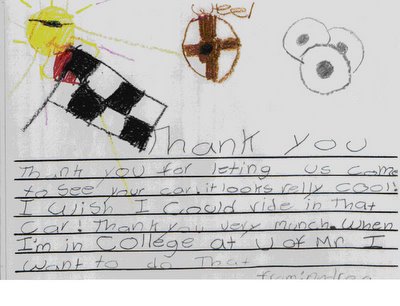
In the age of e-mail, the handwritten note becomes cherished.
NEW YORK (AP) -- Melissa Walker follows a ritual when she opens her daily mail. She goes through all the bills and the boring printed stuff first. Then, if it is one of the lucky days, she takes a deep breath and savors the prize: a handwritten, hand-addressed note from her dear friend in Wisconsin.
E-mail may have revolutionized our communication, making it faster, easier, more practical. But that does not mean the handwritten note is dead. Instead, the act of putting pen to paper seems to have gained in currency. Now, it is what you do to say something special, or heartfelt, or really important.
It is not a question of being e-mail ignorant. Walker, a history professor in South Carolina, spends lots of time on the Internet. But that's just the point. She could easily e-mail her college friend, Janet, but instead they choose entertaining postcards, and dash off a few personal notes, once or even a few times a week.
"It's so much more satisfying," she says, her voice evoking the delicious anticipation you felt as a child when the mailman was expected to bring something special.
"Many people mistakenly think a new technology cancels out an old one," says Judith Martin, who writes the syndicated Miss Manners column. People are charmed by handwritten letters, she says, precisely because they are rarer.
"You glance at an e-mail," Martin says. "You give more attention to a real letter."
Not just older folks do it. A. Michael Noll, a communications professor at the University of Southern California, says he was stunned not long ago when he asked his class of undergraduates whether they wrote letters by hand. "More than half of them raised their hand," he says. Later he asked a different class the same question. Same result.
"Clearly, handwritten letter-writing is very much with us," he said. And why? Noll, who refuses to make his e-mail address public because he hates the barrage in his inbox, can only speculate: "In this day and age, receiving a paper letter becomes unusual, and hence, more treasured -- and clearly more important."
For Kate Spade, the designer famous for her trendy handbags, handwriting is a way of life. She does not use the computer -- ever. She has an e-mail address, but her staff prints out the e-mails for her. It's all about paper.
"Everyone LOVES to get a letter," Spade says, with an enthusiasm that seems to stem from her childhood. "I love sending them. I love getting them."
Spade, who began her business with handbags and later expanded it to paper goods, has just launched a new stationery line, partnering with Crane & Co., the Massachussetts-based company that has been operating since 1801 and supplies the paper used for U.S. currency.
The stationery is boldly colored, with zebra prints or multihued birds, coupled with cute phrases like "Watch less, write more" accompanied by a drawing of a TV. It includes correspondence cards -- "for when you just want to dash off a note," Spade says -- and calling cards, a personal version of the standard business card.
Such high-end stationery reflects the fact that in some circles, the handwritten note has achieved a sense of cachet, a certain je-ne-sais-quoi that it never had before e-mail. Julie Weiss, a graphic designer in New York City who creates unique invitations for affluent clients, compares it to a particularly stylish handbag that everyone wants because it is hard to get.
"I believe the handwritten note has become a status symbol, not unlike a vintage Hermes Birkin bag (they go for thousands, and there is a wait list) in fuschia," Weiss says.
"We get 100 e-mails a day, but a handwritten note only if we're special. The handwritten note is elitist and therefore a must for the fashion-conscious set. Of course, it must be written on fabulously heavyweight monogrammed stationery."
Even those who are not particularly status-conscious eventually realize there are moments when handwritten notes are a must. These include condolence letters, of course -- imagine getting one of those by e-mail -- or thank-you notes for an important gift. Or, as Susan Ross of Westport, Connecticut, found out, reply cards.
Ross, whose son will celebrate his bar mitzvah in March, wondered aloud to her stationer if there was a trend in asking for replies by e-mail.
"She looked at me with absolute disgust," Ross says.
Now, Ross is teaching 13-year-old William how to write fancy thank-you notes. "He was shocked that he couldn't do them on a computer, and didn't seem to have any notion of how to organize a formal note," Ross says -- for example, how to indent, or where to put the date.
"I kept insisting that he must have learned these life skills at school," she says. "And he keeps insisting that he has not."
That's Write,
HMK




























































